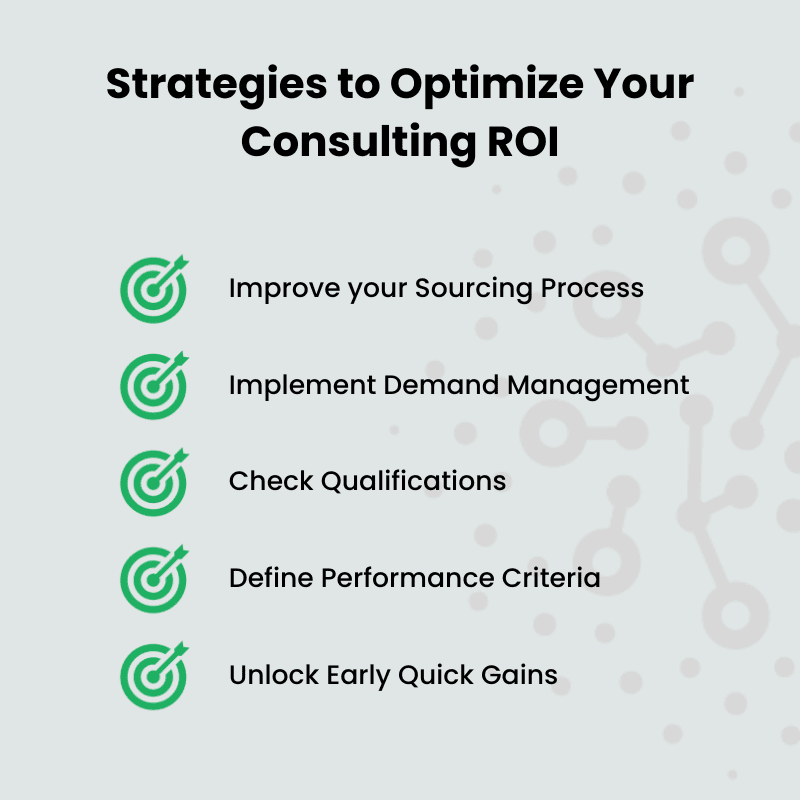In today’s dynamic business environment, understanding and optimizing your consulting ROI has become more crucial than ever.
With the myriad of consulting options available and the significant investments companies make in these services, it’s essential to ensure that every dollar spent translates into tangible business value.
Norman Ralph Augustine humorously noted, “All too many consultants, when asked, ‘What is 2 and 2?’ respond, ‘What do you have in mind?’” This quip underscores the importance of clarity in expectations and outcomes.
While the nuances of consulting engagements can vary, the ultimate goal remains consistent: deriving maximum value from each project and provider. The consultants you decide to partner with can have a profound impact, offering a diverse range of tangible and intangible benefits.
The question then arises: How do decision-makers align their consulting investments with business priorities? And how do they measure and maximize the return on these investments?
Dive in as we explore these questions and unveil strategies to optimize your Consulting ROI.
#1. Improving Your Sourcing Process
Among the key success factors for a project, being outsourced or not, is the clarity of the scope and objectives, and the talent of the team.
To maximize the chances of success of your project, you need to make sure that you have a great RFP that states clearly the context of the project, the goals, and deliverables of the project. Be careful to describe the results you are expecting and not necessarily the means to get them.
Another important aspect is to put your consultants in competition when it is relevant (hint: most of the time). One Consulting Firm can be great on a project, but not the best choice for the next project. Besides, you might want to look at new ideas or compare other approaches.
#2. Implementing Demand Management
You will need to take control of your expenses, in particular when you have a decentralized procurement process for Consulting Services.
Loud statements of intent are very rarely efficient. You need to have a clearly defined, objective decision-making process to make sure the budget for Consulting is spent on your priorities.
Demand Management will help you balance and strategically align demand with your consulting budget.
A simple scan of your consulting expenses can open the door to significant quick gains and value creation. We would like to show you in future posts, how to capture this value early in the process.
#3. Checking Qualifications
First things first – was the firm qualified to do the job? Have they understood the problem you were trying to solve? Have they worked well with your teams? And last but not least, what was the impact and the return on investment?
Collect some information about the Consulting Firm structure, in particular, the partner and/or the project manager in charge.
As you can see, it is not that complex to be on top of your consulting spend and easily evaluate Consultants’ performance.
Once you have understood your consulting Spend and assessed the Performance of your Consulting suppliers, you can start generating the Quick gains.

#4. Defining Performance Criteria
When investing in consulting services, it’s imperative to have a clear set of performance criteria to evaluate the effectiveness of the consultancy firm.
This not only ensures that you get value for your investment but also aids in creating a transparent relationship between your organization and the consultants. Here are some essential criteria you should consider:
Knowledge and Experience in the Field
Were they adept and well-informed in addressing your specific issues? Did their expertise match the complexity of the problems you presented?
Adaptability and Customization
How effectively did they tailor their knowledge and expertise to fit the unique requirements of your project? Were all tasks executed to your satisfaction and standards?
Initiative and Proactivity
Were they forward-thinking? Did they suggest innovative solutions and actively address emerging challenges?
Productivity and Efficiency
Did they adhere to the stipulated timelines, ensuring tasks were completed within the agreed-upon deadlines?
Cooperation and Teamwork Attitude
A harmonious working relationship is vital. Did they foster a positive and cohesive work environment, ensuring seamless collaboration with your internal teams?
Quality of Deliverables
Evaluate the overall quality and impact of their work. Were their outputs up to the mark, resulting in tangible benefits and growth? And if certain aspects were lacking, was there an open channel to provide feedback in a manner that was beneficial for both parties?
Setting and evaluating consultants based on these criteria will not only help in optimizing your Consulting ROI but will also pave the way for fruitful, long-term partnerships. Remember, the goal is not just to hire consultants but to collaborate with them in a way that they become an extension of your team, driving mutual success.
#5. Unlocking Early Quick Gains to Boost Consulting ROI
In today’s digital age, data is the lifeblood of strategic decision-making. Leveraging this data effectively can lead to transformative insights, optimizing how you engage with consulting firms and ensuring that you’re consistently maximizing the ROI on your investments.
Dive Deep into the Data – Uncover Patterns and Anomalies
Begin with a comprehensive analysis. Are specific business units disproportionately high spenders on consulting? You might be surprised to find vast disparities in what different consulting providers charge for similar projects.
For instance, why is a particular consulting firm charging significantly more in Europe than in North America?
Understand Your Project Portfolio
A thorough understanding of your project portfolio provides a foundation to enhance your sourcing strategies. Look for segments and set thresholds.
If you have an in-house consulting team, assess their collaboration with external consultants. What’s the price difference between them and external providers? Is the collaboration seamless?
Familiarize Yourself with Your Consulting Partners
It’s not just about who they are, but also how they perform. Evaluating consulting firms on both demographic and performance metrics can offer a 360-degree view.
For a continually evolving business landscape, consider refreshing your panel by removing underperformers and integrating new entrants.
Play with supplier diversity and find synergies that can be harnessed across various departments and units.
Continuous Monitoring is Key
Lastly, regular scrutiny of your consulting expenses is crucial. By keeping an eye on this, you can focus on elements pivotal to your organization, ensuring that this review process isn’t a one-off but an ongoing exercise to continually optimize your consulting engagements.
Data-driven insights can be your north star in the often complex world of consulting engagements. By staying informed and agile, you can ensure your consulting partnerships are always in alignment with your strategic objectives.
The Path Forward: A Holistic Approach to Maximizing Consulting ROI
While the insights shared in this article provide a strong foundation, they merely touch the tip of the iceberg when it comes to truly optimizing your consulting ROI.
Achieving the best results isn’t just about refining a single process or making isolated decisions; it’s about reimagining the entire way you engage with consulting services.
Engaging All Stakeholders
From internal teams to procurement professionals, and even the consultants themselves, everyone plays a pivotal role. Ensuring alignment and clear communication across all these players is essential.
Pursue the Right Endeavors
Not all projects yield equal value. It’s critical to discern which ventures align best with your organization’s strategic objectives and leverage consultants where they can offer the most value.
People Over Everything
The success of any project hinges on the people driving it. Whether you’re working with consultants or relying on in-house talent, having the right team in place is paramount.
Efficient Procurement and Project Management
Streamlined buying processes and effective project management ensure not only that you’re getting the best bang for your buck but also that projects are executed seamlessly and deliver the desired outcomes.
Forge Long-Term Partnerships
Don’t just view consultants as short-term solutions. Building long-lasting relationships with your consulting providers can lead to consistent value delivery and mutual growth.
Conclusion
In wrapping up, remember that the journey to maximizing consulting ROI is a continuous one, requiring constant evaluation and adjustment.
It’s a holistic endeavor, and with the right strategies in place, you can ensure that every dollar spent on consulting drives meaningful and lasting value for your organization.
consulting roi consulting roi consulting roi consulting roi
consulting roi consulting roi consulting roi consulting roi
consulting roi consulting roi consulting roi consulting roi

How Consource Can Help?
Coming complete with an arsenal of demand management modules, spending analysis, and budget forecasting features, Consource provides real-time visibility into your spend. This comprehensive approach enables you to optimize ROI, by detecting cost-saving opportunities and investing the saving back to other strategic areas.








0 Comments